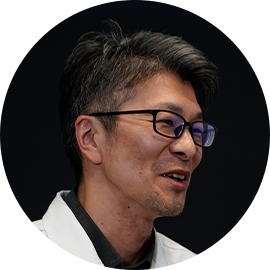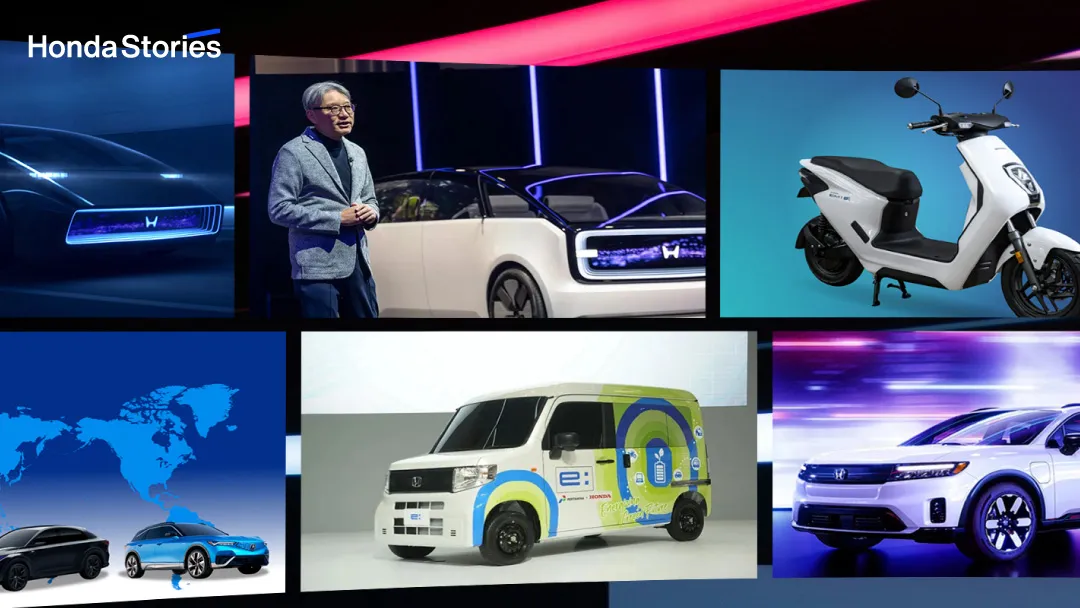Honda is set to release a mass-production EV for North America, the “Prologue”. This model, unlike before, has been realized through a collaborative development with GM. What challenges in advancing collaborative development has Honda, which has traditionally operated on the premise of “developing as much as possible in-house”, overcome? Along with the attractiveness of Prologue, we spoke with two key figures in the development.

Development Leader (LPL/Large Project Leader) for Prologue View More Close John Hwang
Read More
Vehicle Body Design Development Leader for Prologue View More Close Hirokazu Matsuura
Read MoreHonda plans to release the new EV “Prologue” in early 2024 for the North American market. Prologue is the EV categorized as a midsize SUV that is a highly popular in North America. It is a model developed in collaboration with General Motors (GM) and features the EV platform developed by GM equipped with the “Ultium”* battery. With the heightened sensitivity towards sustainability and the increasing shift towards EVs in the North American market, the Prologue, being the first high volume mass-production EV model introduced, is of great significance for Honda.
*The next-generation battery developed by GM
 The “NEO RUGGED” concept aims for a simple and refined design while embodying a robust outdoor style that exudes strength. One of its features is that it is larger than the SUVs sold in Japan
The “NEO RUGGED” concept aims for a simple and refined design while embodying a robust outdoor style that exudes strength. One of its features is that it is larger than the SUVs sold in Japan
Specialized for North American needs. The key word is “RUGGED”.
Prologue falls into the midsize category, a size that is quite popular in North America. John Hwang, who served as the Development Leader
(LPL), introduces the characteristics of the North American market and says the following.

In the collaborative development, Honda took charge of the styling area, including the exterior and interior, known as the “top hat”. Hirokazu Matsuura, who served as the assistant development leader with a focus on design, reflects on the collaborative development with GM as follows.

Originally, Honda has excelled in the development of small and midsize cars. In developing a midsize SUV larger than those sold in Japan, which is popular in North America, the expertise of GM accustomed to developing large-sized vehicles was very valuable.
The challenges overcome in collaborative development and the insights gained
At the same time, there were challenges unique to the collaborative development. One of them was finding a balance with Honda's ingrained mindset of “try everything first and aim to complete it ourselves”. According to Matsuura, in the collaborative development with GM, there was a need for even more segregation of responsibilities and communication than before, which initially posed some challenges.

Naturally, the development of a car involves the participation of many people, and progress is made in various areas such as the “exterior” and the “motor”. In a way, specialists in each area take charge. However, for better or for worse, Honda tends to think about areas beyond its assigned responsibilities and strives to make them better. That is one aspect of the corporate culture. On the other hand, GM strictly adheres to the assigned areas for each individual. It was a good opportunity to experience a culture different from our own.
Also, there were geographical challenges. Honda's development base is in Japan, GM's base is in the United States, and the design studio is also in the United States but in a different location, leading to scattered bases. In addition, 2020, the year the project started, was a time when the world was grappling with the severe impact of COVID-19, making face-to-face discussions difficult.


For the first year or two, meetings could only be conducted remotely, making it challenging to discuss matters while actually looking at physical objects. As a result, there was a greater reliance on utilizing VR and CG to advance development. While there were challenges, looking back, the trial and error experienced in development using these new methods will be valuable experiences for the future.
At the same time, there was a renewed appreciation of the importance and benefits of meeting in person for face-to-face discussions. Of course, we were communicating remotely, but when I traveled for face-to-face meetings after the pandemic settled down a bit, there was a sense of familiarity, and subsequent discussions progressed more smoothly.

 The development environment utilizing VR and CG
The development environment utilizing VR and CG
A car that marks the “prologue” to the era of electric vehicles
Overcoming various challenges such as cultural differences between the two companies and initially being forced into remote communication across multiple locations, Prologue is finally set to make its debut.
As the name indicates, Prologue conveys the importance and strong determination in Honda's EV expansion in North America.
 Prologue made its debut and garnered attention at the Japan Mobility Show 2023 held in the fall of 2023
Prologue made its debut and garnered attention at the Japan Mobility Show 2023 held in the fall of 2023

In the case of Prologue, while taking inspiration from the advanced and stylish design of its predecessor, the “Honda e”, as an EV, it also values familiarity like that of vehicles with conventional engines, focusing on ease of use. The name Prologue not only signifies the prologue for Honda, but also reflects the desire to make it the first step for customers to smoothly shift from vehicles with traditional engines to EVs.
The main target audience for the vehicle is young families. The goal is not only to attract early adopters of EVs--the main customer base so far--but also to create a car that is loved by a wide range of users. It is said that by offering not only a single motor FWD but also a dual-motor 4WD, we aimed at delivering a sporty and powerful driving experience demanded in North America.
 The interior features high-quality materials and a simple design with a horizontal lines
The interior features high-quality materials and a simple design with a horizontal lines
In response to the demand for connectivity in modern cars, this car supports Apple CarPlay and Android Auto™. Addressing the unique challenge of charging in EVs, it is equipped with features that help users decide where to charge during a journey. Additionally, it includes functions that, based on the battery's condition adjustment, allow for quick charging upon reaching a charging spot.
However, it is not just packed with the latest technologies. One example that Matsuura mentions is the interior switches. Rather than completely eliminating physical switches, we deliberately kept ones that are used while driving. Unlike physical switches, it is difficult to instantly determine whether a touch panel has been properly operated, and there is a potential risk while driving. Prologue is dedicated to earnestly adopting the user's perspective and thoroughly pursuing safety and convenience.
■Apple CarPlay is a trademark of Apple Inc., registered in the U.S. and other countries
■Android Auto™ is a trademark of Google LLC
 The interface features a high-quality 11-inch Digital Instrument Display and an intuitive 11.3-Inch touchscreen
The interface features a high-quality 11-inch Digital Instrument Display and an intuitive 11.3-Inch touchscreen
Pursuing the “Honda’s uniqueness” that can be felt even in an EV
Prologue is not only attractive in terms of features and interior but also boasts an appealing exterior.

Prologue's distinctive feature is its styling, which, while giving a rugged impression, also appeals with simplicity and cleanliness. Furthermore, instead of the traditional “H” emblem, Prologue has “Honda” engraved on the rear end. It not only presents a fresh image as an EV but also boasts a wider and more eye-catching proportion in terms of vehicle size.
 The rear end with “Honda” engraved on it. It is expected to stand out as a presence that distinguishes itself from the mass-production cars released so far
The rear end with “Honda” engraved on it. It is expected to stand out as a presence that distinguishes itself from the mass-production cars released so far

At the Japan Mobility Show, we were often asked, “Is this an EV?” It wasn't just for early adopters; we planned it as a general “Neo-Rugged EV”, and it seems to have turned out as intended. We have received questions like “Won't it be sold in Japan?” due to its highly attractive proportions, and we are very pleased with that.
 In between interviews, the two share a laugh. Amidst the challenges of a project full of firsts, Hwang praised Matsuura, who has lived in both Japan and the United States, and has extensive project experience, for driving forward the current project
In between interviews, the two share a laugh. Amidst the challenges of a project full of firsts, Hwang praised Matsuura, who has lived in both Japan and the United States, and has extensive project experience, for driving forward the current project
For the Japanese market, Honda plans to release a light commercial EV based on the “N-VAN” in 2024, an EV based on the “N-ONE” in 2025, and two small EV models including an SUV type in 2026. It is conceivable that various other types will continue to be introduced over time. In the future, how do you plan to leverage the experiences gained through the development of Prologue?

Due to the differences in size and the desired driving performance, Prologue cannot be brought to Japan as it is. For the future, we will optimize the battery and platform, discern market characteristics in the era of EVs, and advance development unique to Honda.

As we shift to EVs, there will be differences in architecture, but even with this, we want to make developments where you can truly feel “Honda’s uniqueness”. We have high expectations for the Prologue as a stepping stone in that direction.
Prologue embodies Honda in the era of EVs, continuing to realize the traditional strength of the “joy of driving”. Please watch and see how it will demonstrate its presence as the prologue to people's shift to EVs.

※The model introduced at this time is exclusive to North America. There are no plans for a release in other regions.
Original article issued on January 26, 2024
<Related Articles>



![[Infographic] Understanding Honda's Automobile Electrification Strategy in Three Minutes - Exploring the Environment that Surrounds Electric Vehicles and Honda's Vision](/content/dam/site/global-en/stories/cq_img/075/social.jpg)







When introducing an SUV-type EV in North America, the first and foremost importance lies in the uniqueness of the styling and the size. In Prologue, we focused on the needs of the North American users and finished with a styling that gives a rugged impression.
Additionally, considering it's an EV, the driving range is also an important aspect. In that regard, the collaboration with GM, who was in charge of the platform including motors and batteries, proved to be very effective.